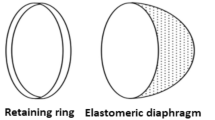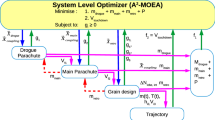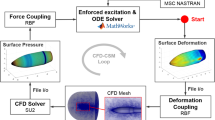Abstract
Elastomer diaphragm tanks have been adopted in many spacecraft applications, such as upper stages, space platforms, commercial and civil spacecraft as a propellant tank in which liquid propellant is covered with a diaphragm and compressed into a combustion chamber by gas pressure. Investigating the dynamic response and the influence of various parameters on the modal properties is a significant issue in the modeling of the space diaphragm tanks. In this work, the numerical study is presented to investigate the modal properties of a spherical fuel tank in both uncovered and covered cases with a flexible diaphragm as fluid–structure interacting situations. The filling volume ratio of fluid ranges is from 25 to 50%. Numeric dynamic simulations created by ANSYS software are verified by the experimental results of test tank and then, the validation of the numeric model is used to determine the natural frequencies and mode shapes of really elastomer diaphragm tank as the second case study for two conditions: fluid filling volume ratio of 80% that the tank is in full load condition and liquid filling volume ratio of 14% when the diaphragm completely inverted. After that, the best layout of diaphragm tanks in two-story satellite is detected by calculating deviations from center of gravity and cross moments of inertia objective functions in multi objective optimization software. Then the natural frequencies of satellite include diaphragm tanks computed and compared with natural frequencies and static loads of launch vehicle requirements. The achieved results of this study showed that the numeric simulations are able to renovate the experimental vibration characteristics of the diaphragm tank with a good precision. In addition numeric model can detect the best layout of diaphragm tank components.


































Similar content being viewed by others
Abbreviations
- E :
-
Young’s modulus
- h :
-
Liquid height
- η :
-
Liquid volume
- ν :
-
Poisson’s ratio
- ρ :
-
Density
- μ :
-
Viscosity
- fc :
-
Natural frequencies
- PMD:
-
Propellant management device
References
Abramson HN (1966) The dynamic behavior of liquids in moving containers. NASA SP-106. NASA Special Publication, p 106
Accardo G, El-Kafafy M, Peeters B, Bianciardi F, Brandolisio D, Janssens K, Martarelli M (2015) Experimental acoustic modal analysis of an automotive cabin. Experimental techniques, rotating machinery, and acoustics, vol 8. Springer, Cham, pp 33–58
Ballinger I, Lay W, Tam WJAJ (1995) Review and history of PSI elastomeric diaphragm tanks. In: 31st Joint Propulsion Conference and Exhibit, p 2534
Bauer HF, Chiba M (2000) Hydroelastic viscous oscillations in a circular cylindrical container with an elastic cover. J Fluids Struct 14(6):917–936
Bauer HF, Chiba M (2005) Axisymmetric oscillation of a viscous liquid covered by an elastic structure. J Sound Vib 281(3–5):835–847
Bauer HF, Chiba M (2007) Viscous oscillations in a circular cylindrical tank with elastic surface cover. J Sound Vib 304(1–2):1–17
Chiba M (1993) Non-linear hydroelastic vibration of a cantilever cylindrical tank—I. Experiment (empty case). Int J Non-Linear Mech 28(5):591–599
Chiba M, Yamaki N, Tani J (1985) Free vibration of a clamped-free circular cylindrical shell partially filled with liquid—part III: experimental results. Thin-Walled Struct 3(1):1–14
Chiba M, Murase R, Kimura R, Yamamoto Y, Komatsu K (2016) Experimental studies on the dynamic stability of liquid in a spherical tank covered with diaphragm under vertical excitation. J Fluids Struct 61:218–248
Curadelli O, Ambrosini D, Mirasso A, Amani M (2010) Resonant frequencies in an elevated spherical container partially filled with water: FEM and measurement. J Fluids Struct 26(1):148–159
Deb K, Karthik S (2007) Dynamic multi-objective optimization and decision-making using modified NSGA-II: a case study on hydro-thermal power scheduling. In: International conference on evolutionary multi-criterion optimization. Springer, Berlin, Heidelberg, pp 803–817
Eberle F, Goeller B, Krieg R (1990) Comparison between calculated and measured eigenfrequencies for spherical steel containment shells. Nucl Eng Des 120(1):15–23
Fakoor M, Ghoreishi SMN, Sabaghzadeh H (2016) Spacecraft component adaptive layout environment (SCALE): an efficient optimization tool. Adv Space Res 58(9):1654–1670
Goncalves PB, Batista RC (1987) Frequency response of cylindrical shells partially submerged or filled with liquid. J Sound Vib 113(1):59–70
Guan H, Xue Y, Wei Z, Wu C (2018) Numerical simulations of sloshing and suppressing sloshing using the optimization technology method. Appl Math Mech 39(6):845–854
Huang B, Buckley B, Kechadi TM (2010) Multi-objective feature selection by using NSGA-II for customer churn prediction in telecommunications. Expert Syst Appl 37(5):3638–3646
Jalali H, Parvizi F (2012) Experimental and numerical investigation of modal properties for liquid-containing structures. J Mech Sci Technol 26(5):1449–1454
Jeong KH, Lee SC (1998) Hydroelastic vibration of a liquid-filled circular cylindrical shell. Comput Struct 66(2–3):173–185
Jindal SK, Raghuwanshi SK (2015) A complete analytical model for circular diaphragm pressure sensor with freely supported edge. Microsyst Technol 21(5):1073–1079
Leuva D (2011) Experimental investigation and CFD simulation of active damping mechanism for propellant slosh in spacecraft launch systems. MSc Thesis, Embry Riddle Aeronautical University, Daytona Beach, FL
Levine DV (2014) Flexible slosh diaphragm modeling and simulation in propellant tanks. Doctoral dissertation
Ley W, Wittmann K, Hallmann W (2009) Handbook of space technology, vol 22. Wiley, New York
Liu Z, Yi C (2008) The analysis of vibro-acoustic coupled characteristics of ball mill cylinder under impact excitation. Mod Appl Sci 2(6):37–40
Luo ZQ, Chen ZM (2011) Sloshing simulation of standing wave with time-independent finite difference method for Euler equations. Appl Math Mech 32(11):1475–1488
Mazuch T, Horacek J, Trnka J, Veselý J (1996) Natural modes and frequencies of a thin clamped—free steel cylindrical storage tank partially filled with water: fem and measurement. J Sound Vib 193(3):669–690
Miettinen VM, Vallittu PK (1997) Water sorption and solubility of glass fiber-reinforced denture polymethyl methacrylate resin. J Prosthet Dent 77(5):531–534
O’hara GP (1983) Mechanical properties of silicone rubber in a closed volume (No. ARLCB-TR-83045). Army armament research and development center watervliet NY large caliber weapon systems lab
Rebouillat S, Liksonov D (2010) Fluid–structure interaction in partially filled liquid containers: a comparative review of numerical approaches. Comput Fluids 39(5):739–746
Sances D, Gangadharan S, Sudermann J, Marsell B (2010) CFD fuel slosh modeling of fluid-structure interaction in spacecraft propellant tanks with diaphragms. In: 51st AIAA/ASME/ASCE/AHS/ASC structures, structural dynamics, and materials conference 18th AIAA/ASME/AHS adaptive structures conference 12th, p 2955
Shelley R, Ross WL (1993) “APU diaphragm testing,” NASA-TM-108254, March, 1993
Sivak VF, Telalov AI (1991) Experimental investigation of vibrations of a cylindrical shell in contact with a liquid. Int Appl Mech 27(5):484–488
Tam W, Jaekle D (2018) Space propulsion, Barcelo Renacimiento Hotel, Seville, Spain/14–18 May 2018, Review of ATK Diaphragm Tanks–An Update
Tao R, Yang QS, Liu X, He XQ, Liew KM (2018) Investigation of intelligent reversible diaphragm using shape memory polymers. J Intell Mater Syst Struct 29(7):1500–1509
Titow W (1984) PVC technology. Elsevier Applied Science Publishers, London. ISBN 978-0-85334-249-6
Tran D, He J (1998) Modal analysis of circular cylindrical tanks containing liquids. In: Proceedings of the 16th international modal analysis conference, vol 3243, p 1636
Vincent J, Carella JM, Cisilino AP (2014) Thermal analysis of the girth weld of an elastomeric diaphragm tank. J Mater Process Technol 214(2):428–435
Welsch G, Boyer R, Collings EW (1993) Materials properties handbook: titanium alloys. ASM International, New York
Wiśniewski A, Kucharski R (2006) Eigencharacteristics of fluid filled tanks: an extended symmetrical coupled approach. Task Q 10(4):455–468
Zhang Y, Reese JM, Gorman DG (2002) A comparative study of axisymmetric finite elements for the vibration of thin cylindrical shells conveying fluid. Int J Numer Meth Eng 54(1):89–110
Author information
Authors and Affiliations
Corresponding author
Additional information
Publisher's Note
Springer Nature remains neutral with regard to jurisdictional claims in published maps and institutional affiliations.
Rights and permissions
About this article
Cite this article
Sabaghzadeh, H., Shafaee, M. Investigation of modal properties and layout of elastomer diaphragm tanks in telecommunication satellite. Microsyst Technol 26, 1931–1959 (2020). https://doi.org/10.1007/s00542-020-04746-4
Received:
Accepted:
Published:
Issue Date:
DOI: https://doi.org/10.1007/s00542-020-04746-4




